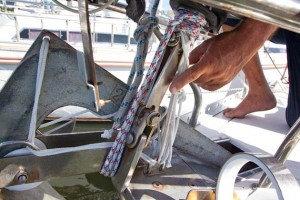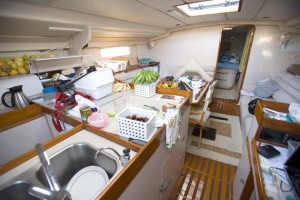What’s the best equipment?
Equipping a yacht for ocean cruising is an expensive business. Starting with safety equipment, all the gear needed for compliance with ISAF regulations to take part in an organised event can add up to as much as £5,000-10,000 if starting from scratch.
Then there are new sails to consider, upgraded electronics, communications gear or big ‘comfort’ items such as watermaker and generator. So, if you are making a priority list, which additions do our panel consider the most useful?
‘There are lots of dependencies on the number of crew here,’ advises Kurt Lillywhite. ‘On a four- to six-person yacht a good quality autopilot is essential, ideally a doubled-up system if four or less are on board, as six or nine hours a day on the wheel can become very tiring.
‘From having spent time on boats, from race yacht to luxury superyachts with huge power demands, the one lesson I’ve learned is that whatever the new, clean power systems available you can’t beat a good diesel genset. Wind generators tend not to produce the power you hope on the east to west crossing as apparent wind speeds aren’t high enough.’ Our annual ARC gear surveys back this up, but found wind generators very useful when in the Caribbean.
‘With solar power remember that when in the shade of sails, panels lose over 50 per cent of their rated efficiency. I have had great experience with modern water generators now, but so far only on yachts that can average around eight knots; below that I found the power generation disappointing.
‘Then buy a high-quality charging solution – this is very important to minimise the number of hours you are going to run. I favour AGM batteries as they are “fit and forget” and have the highest charge rates, typically 20 per cent of a 20hr rate. If set up properly you should never need to run the generator for more than four hours per day.
‘The third item is a watermaker, I have been extremely impressed by the latest generation of small DC units. On the last ARC I was skipper of an 80ft yacht with high-pressure showers, freshwater heads, even an ice maker, so water demands can be huge. We fitted a back-up 35lt/hr DC unit to complement the 260lt/hr main unit. We started out testing the new unit and ended up using it for the whole crossing. It ran faultlessly, kept the tanks topped up no problem and drew less than 4amps at 24V.’
Skippers’ tips – Clean and check
‘Keeping the boat clean and polished sounds vain, but in doing so I have discovered bolts coming loose on a spinnaker track, a shackle falling out of roller reefing, spinnaker pole locking plunger on deck, etc.’ Paul Redman
Ross Applebey agrees. ‘If short-handed, a good autopilot or self-steering is a must, but fully crewed I would say an autopilot is not needed. With more crew, water consumption and food consumption increases, so a watermaker and perhaps a freezer are very handy.’
Despite the obvious advantages of a diesel generator, alternative energy solutions can be a quiet and reliable method of charging on smaller yachts. ‘Provided you have sufficient boat speed, a Duogen in water mode is what I chose over a diesel generator because it is not noisy, noxious, fuel consuming and is outside the boat,’ says Allan Dobson. ‘In 2013, which was a fast crossing, the Duogen alone, in water mode, produced enough power to run everything.’
Dan and Em Bower, who run Skyelark as a charter yacht and wrote our recent Bluewater Sailing Techniques series, put at the top of their kit list ‘a good sat comms set-up to allow you to download weather files. Being able to plot a route to make the best use of the winds and potentially avoid any adverse weather can make a big difference to the trip.
They also say a satellite phone is indispensable and ‘very useful in case of any emergency. Being able to pick up the phone and immediately inform the coastguard of any disaster and knowing that help is on its way is very reassuring.’
How to keep it simple and reliable
They, too, consider power generation a priority, and they have a word of caution. ‘We have a compact petrol generator on deck, which has been very reliable compared with our larger diesel generator, which has spent the majority of its life in pieces and not working.’
Paul Redman is also a fan of a portable petrol generator. ‘I’ve kept my boat simple. I have a Honda petrol generator 2000i for electricity which cost approximately £1,700, has made eight crossings and it has never missed a beat. I have only ever had to change the oil.
‘Our Cob Oven [www.cobb-bbq.co.uk] has saved endless amounts of gas and has been used to cook meat, bread and cakes. Our Katadyne watermaker makes 5lt/hr, is simple to use and fills crew’s personal bottles for tea and coffee.’
Ease of servicing and maintenance is an area many cruising yachtsmen sometimes neglect to consider, to their cost. The maxim that everything that can break eventually will holds all too true on a long-term cruise.
Skippers’ tips – Make stowage easier
‘I should have spent more on stowage arrangements to give easier access to lockers, for example, from the fronts of the saloon lockers to avoid having to wrestle cushions on and off the settees to get to the lockers’ contents. I should also have put internal dividers into some lockers and the lazarettes.’ Allan Dobson
‘You must be able to get at anything that might need fixing,’ warns Stephen Kingsman. ‘If, like me, you are not a trained engineer, things have to be simple enough to understand. It’s no fun finding yourself miles away from anywhere worrying about something really vital breaking that you have no idea how to replace, repair or at the very least temporarily bodge up to keep you going.’
But he continues: ‘The whole range of other more complicated luxuries you can have on board such as wi-fi driven systems, domestic appliances and things that rely on printed circuit boards that were never intended to be on a boat are all fine as long as you can accept that at some stage they will probably break down. Too many skippers lose too much sleep worrying about getting things fixed.
‘Do not forget that nearly everyone leaves to cross the Atlantic at roughly the same time and the back-up services in the departure ports really do get overwhelmed trying to get all the boats sorted over what is a very limited time period. It may sound obvious, but make sure you thoroughly use everything on board for at least six months before a long crossing.’
And on that score, make sure you take along all the tools and spares you are likely to need – even if you get an engineer to fix or service equipment, having the right parts on board will speed things up and avoid expensive shipping and import complications.
‘Spares, spares, spares, along with tools, tools, tools,’ advises Kurt Lillywhite. ‘Take everything from every type of tape, glue, screw, nut and bolt, electric connectors, fuses and wire you might need. Pipe fittings (the current push-fit piping used by most European manufactures is great, but if it does leak resealing is almost impossible) and check to make sure you really do have a socket or spanner that fits everything, especially rigging screws and steering gear.’
But don’t overthink things, says Stephen Kingsman: ‘Make sure that the boat does not take over your life. You are there to have fun and enjoy the trip, not to be continually working for the boat.’








